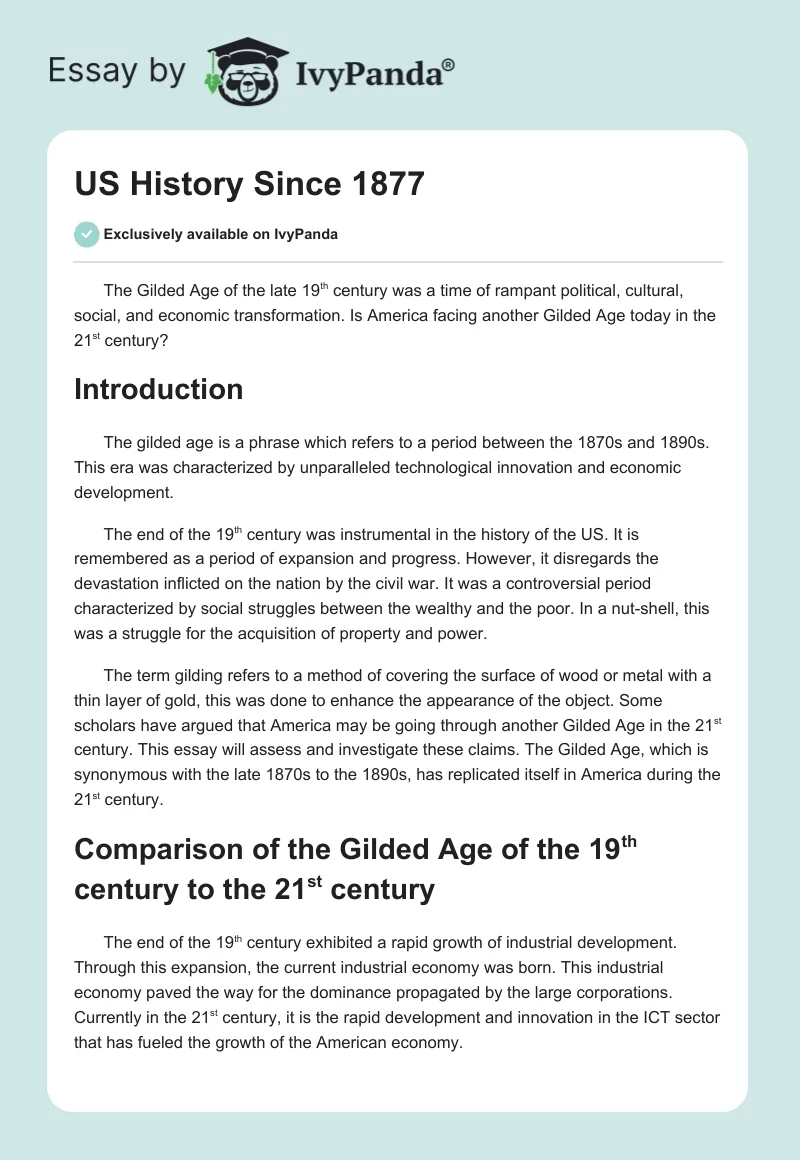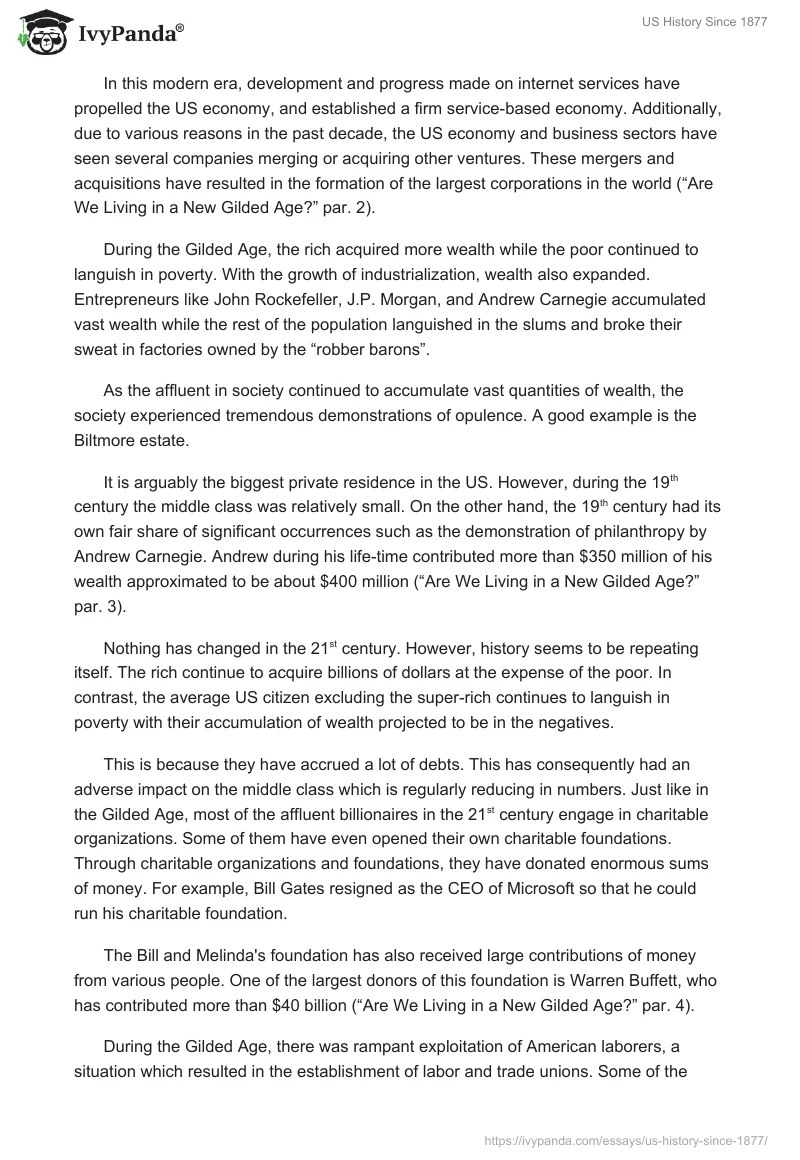The Gilded Age of the late 19th century was a time of rampant political, cultural, social, and economic transformation. Is America facing another Gilded Age today in the 21st century?
Introduction
The gilded age is a phrase which refers to a period between the 1870s and 1890s. This era was characterized by unparalleled technological innovation and economic development.
The end of the 19th century was instrumental in the history of the US. It is remembered as a period of expansion and progress. However, it disregards the devastation inflicted on the nation by the civil war. It was a controversial period characterized by social struggles between the wealthy and the poor. In a nut-shell, this was a struggle for the acquisition of property and power.
The term gilding refers to a method of covering the surface of wood or metal with a thin layer of gold, this was done to enhance the appearance of the object. Some scholars have argued that America may be going through another Gilded Age in the 21st century. This essay will assess and investigate these claims. The Gilded Age, which is synonymous with the late 1870s to the 1890s, has replicated itself in America during the 21st century.
Comparison of the Gilded Age of the 19th century to the 21st century
The end of the 19th century exhibited a rapid growth of industrial development. Through this expansion, the current industrial economy was born. This industrial economy paved the way for the dominance propagated by the large corporations. Currently in the 21st century, it is the rapid development and innovation in the ICT sector that has fueled the growth of the American economy.
In this modern era, development and progress made on internet services have propelled the US economy, and established a firm service-based economy. Additionally, due to various reasons in the past decade, the US economy and business sectors have seen several companies merging or acquiring other ventures. These mergers and acquisitions have resulted in the formation of the largest corporations in the world (“Are We Living in a New Gilded Age?” par. 2).
During the Gilded Age, the rich acquired more wealth while the poor continued to languish in poverty. With the growth of industrialization, wealth also expanded. Entrepreneurs like John Rockefeller, J.P. Morgan, and Andrew Carnegie accumulated vast wealth while the rest of the population languished in the slums and broke their sweat in factories owned by the “robber barons”.
As the affluent in society continued to accumulate vast quantities of wealth, the society experienced tremendous demonstrations of opulence. A good example is the Biltmore estate.
It is arguably the biggest private residence in the US. However, during the 19th century the middle class was relatively small. On the other hand, the 19th century had its own fair share of significant occurrences such as the demonstration of philanthropy by Andrew Carnegie. Andrew during his life-time contributed more than $350 million of his wealth approximated to be about $400 million (“Are We Living in a New Gilded Age?” par. 3).
Nothing has changed in the 21st century. However, history seems to be repeating itself. The rich continue to acquire billions of dollars at the expense of the poor. In contrast, the average US citizen excluding the super-rich continues to languish in poverty with their accumulation of wealth projected to be in the negatives.
This is because they have accrued a lot of debts. This has consequently had an adverse impact on the middle class which is regularly reducing in numbers. Just like in the Gilded Age, most of the affluent billionaires in the 21st century engage in charitable organizations. Some of them have even opened their own charitable foundations. Through charitable organizations and foundations, they have donated enormous sums of money. For example, Bill Gates resigned as the CEO of Microsoft so that he could run his charitable foundation.
The Bill and Melinda’s foundation has also received large contributions of money from various people. One of the largest donors of this foundation is Warren Buffett, who has contributed more than $40 billion (“Are We Living in a New Gilded Age?” par. 4).
During the Gilded Age, there was rampant exploitation of American laborers, a situation which resulted in the establishment of labor and trade unions. Some of the exploitations included prolonged working durations, low wages, and poor working environments. Consequently, Samuel Gompers established the AFL in 1886. After the foundation of the AFL, the period was characterized by a sequence of strikes.
The most memorable strike in this era was the Pullman Strike in 1894 (par. 5). In the 21st century, most of the labor movements have been ostracized by the political administration. As a result, the large corporations have started to exploit American workers. However, this is not in the hazardous manner experienced in the Gilded Age. For instance, Microsoft Corporation demanded that its employees should work for extra hours without overtime pay.
The company was subsequently sued for this violation in 2004. In comparison to the Gilded Age, very few American workers are members of any labor union. It is estimated that about 7.6% of the private sector workers have membership in a labor union (“Are We Living in a New Gilded Age?” par. 6).
In reference to politics, the Gilded Age was tainted by massive allegations of corruption across the political divide. It was also characterized by the dominance of local politics over national interests. As a consequence, the elections were highly contested and registered a very high voter turnout. In addition, political campaigns were not based on factual issues.
They were predominantly focused on sensational mud-slinging. In the 20th and 21st centuries, the terms of the recent four presidents have been tainted by various scandals, the only exception being George H.W. Bush. Voter turnout in the elections has also significantly increased.
The elections in the year 2000 were closely contested. Additionally, the national political machinery has overwhelmingly dominated local politics in the US. From various observations, the electorate can infer that the local priorities are not considered at the national level in the dominant political parties (“Are We Living in a New Gilded Age?” par. 7-8).
Most scholars argue that the Gilded Age ended due to the anxiety experienced in 1893. The US experienced an economic recession for at least 4 years. This recession was occasioned by poor monetary policies, overspending on railroads, and doubtful funding of railroad projects. During this period, more than 500 banks collapsed, and it is referred to as the great depression. Currently in the 21st century, there is a similar economic recession.
The causes of this recession are similar to what caused the great depression. They include poor monetary policies, over speculation of property, and dubious funding in real estate. As a consequence, savings increased dramatically while expenditure decreased. Ironically, this economic recession has been compared to the great depression (“Are We Living in a New Gilded Age?” par. 9).
Conclusion
The Gilded Age, which is synonymous with the late 1870s to the 1890s, has replicated itself in America during the 21st century. A significant point to note is that the Gilded Age paved the way for the progressive era. The progressive era came with a lot of reforms that were particularly addressing the causes of the Gilded Age.
The same can be inferred from the reforms being proposed by Congress. The Congress is seeking economic and social reforms among others. The occurrences being experienced might just be a repeat of the Gilded Age referred to as the “New Gilded Age” of the 21st century.
Works Cited
Are We Living in a New Gilded Age? 2013. Web.


